Namespace, Name server, Zone | Domain Name System - DNS Components | 12th Computer Applications : Chapter 12 : DNS (Domain Name System)
Chapter: 12th Computer Applications : Chapter 12 : DNS (Domain Name System)
DNS Components
DNS
Components
There are three important components in the Domain
Name System. They are
● Namespace
● Name
server
● Zone
Name Space
The domain names must be very unique and
appropriate. The names should be selected from a names pace. The name space can
be organized in two ways
● Flat
name space
● Hierarchical
name space
Flat name space is where the name is assigned to
the IP address. They do not have any specific structure. In this flat name
space, some meaningful names are given to IP address for accessing. The major
disadvantage of flat name space is that they cannot be used in large system.
Because they need to be accessed and controlled centrally to avoid ambiguity
and redundancy. But it is difficult in flat name system. To avoid this major
disadvantage hierarchical name space is used in large.
Hierarchical name space is where the name is made
up of several parts. The first part may represent the nature of organization,
the second part may represent the name of organization, and third part may
represent the department of the organization and so on. In this way the power
to control the name space can be decentralized.
Domain Name Space
Domain name space was designed to achieve
hierarchical name space. In this, the names are represented as a tree like
structure with root element on the top and this tree can have a maximum of 128
levels starting from root element taking the level 0 to level 127.
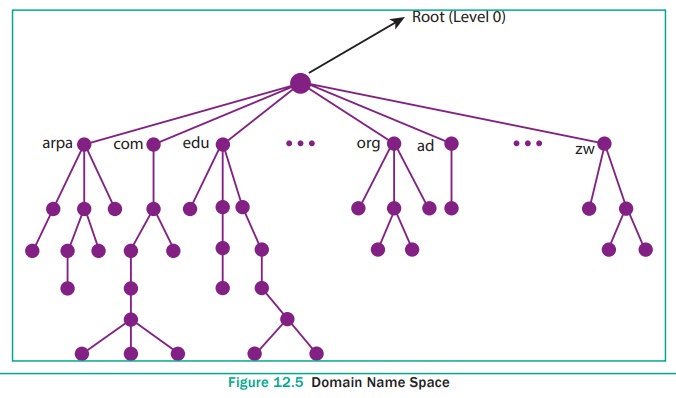
Figure 12.5 represent the domain name space where
the root element is present at the top most level i.e., level 0. The root
element always represents the NULL string (empty string). The next level to the
root element is node (children of root element). Each node in the tree has a label and a domain name.
Label
It is a string which can have maximum of 63
characters. Each node in that level should have different labels thereby assuring
the individuality of the domain name.
In other words, Labels are the names given to
domains. Domain is a sub tree in
domain name space tree structure. The domain can be further divided into sub
domains.
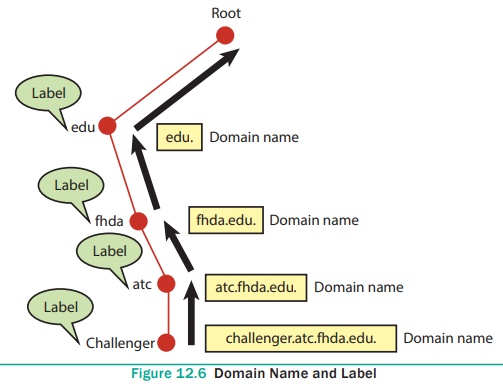
Figure 12.6 explain the domain name and label
clearly. challenger.atc. fhda.edu. is the domain name which is obtained by
reading the labels from bottom to top, separating each label by dot (.) Refer
Figure 12.7
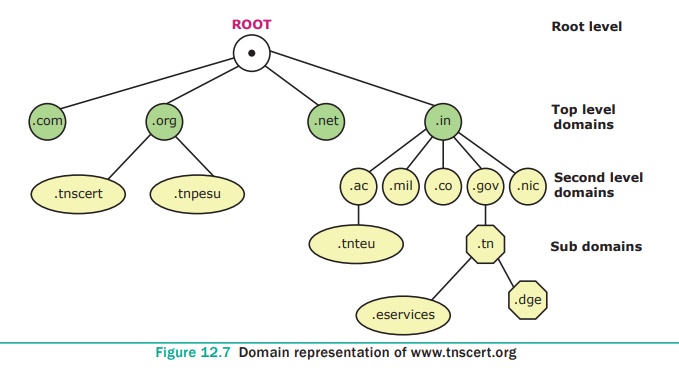
Domain name
It is the sequence of labels. In domain name the
sequence of labels are separated by dot (.). The domain name is always read
from the lower level to higher level i.e., from the leaf node to root node.
Since the root node always represent NULL string, all the domain name end with
dot.
Basic rules of Domain names
● Domain can consists of Alphabets a through z, and
the digits 0 through 9.
● Hyphens are allowed, but hyphens can not be used
as first character of a domain name.
● Spaces are not allowed
● Special symbols (such as !, $, &, _ and so
on) are not permitted.
● Domain
names have the minimum length of 2, and the maximum length of 63 characters. The entire name may be at most 253
characters long.
● Domain
names are not case-sensitive. (It may be upper, lower or mixing of both case
letters)
Generic Top-Level Domain names:
Top level domain is the last part of a domain name.
Generic top level domains are used for generic purpose and maintained by IANA.
Refer Table 12.1
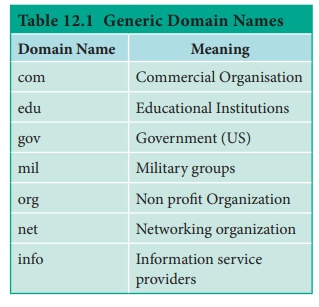
Country top-level domain names
Country domain uses 2-character country
abbreviation according to country. For e.g., google.in – for INDIA, google.us
for US. Refer Table 12.2
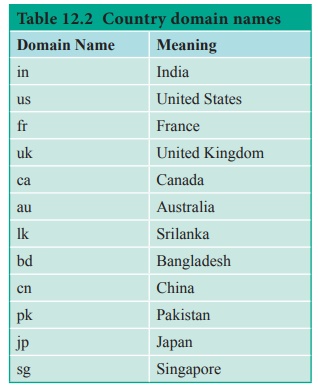
Domain names may also be used in
other than English languages in UNICODE format. Tamil language is also used in
three country Top Level Domain names which are. இந்தியா,.சிங்கப்பூர் and .இலங்கை
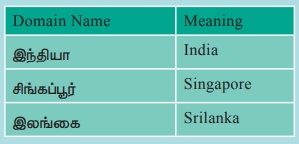
Name Server
The information which needs to be stored in Domain
name space is quite large. Single system would be inefficient and insufficient
to store such a huge amount as responding to requests from all over the world.
It also becomes unreliable because in case of any failure the data becomes
inaccessible.
The solution to this problem is to distribute the
information among many computers. The best way to do that is to divide the
entire space into many domains and sub domains. DNS also allows domains to be
further divided into sub domains. By this, the solution to the problem is
obtained and hierarchy of servers is also maintained. Name servers store the
data and provide it to clients when queried by them. Name Servers are programs
that run on a physical system and store all the zone data.
Inverse domain performs the opposite
task of normal DNS query. It converts the IP address to domain name.
Name Server is a main part in the Domain Name
System (DNS). It translate the domain names to IP addresses. Name server
contains the DNS database which consists of domain names and their
corresponding IP addresses. There is a need to store large number of domain
names for the world wide usage, so plenty of servers are used in the
hierarchical manner. Name servers do the important task of searching the domain
names. While you searching a website, Local Name server (provided by ISP) ask
the different name servers until one of them find out your answer. At last it
returns IP address for that domain name. Your computer can now connect to the
requested webpage stored on the webserver. Refer Figure 12.8.
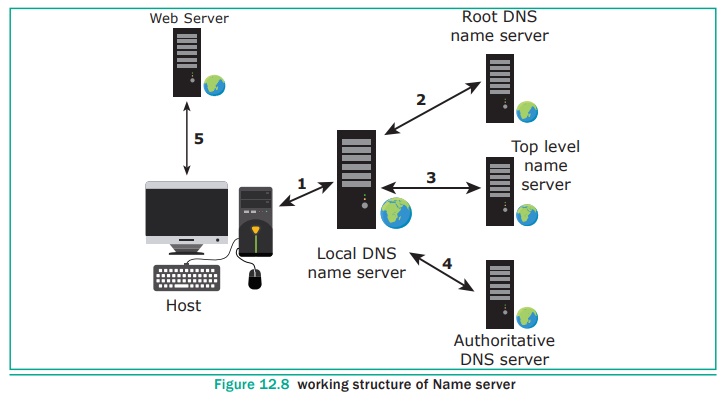
Types of Name Servers
There are three types of Name Servers which control
the entire Domain Name System:
1. Root Name Server - top level server which
contains entire DNS tree, maintained by ICANN. There are 13 servers.
2. Primary/Master Name Server– contains a zone
resource records. These records are updatable by domain name holders such as
organizations.
3. Secondary/Slave Name Server – contains a copy of
primary server files. This server has no authority to update, but reduce the
workload of master server by sharing the queries.
ICANN, Internet Corporation for
Assigned Name and Numbers is the Non-profit Organization which assigns names
and numbers for all Internet resources like domain names and IP addresses.

Zone
The entire name space is divided into many
different zones. It is the area up to which the server has access. Zone is
defined as a group of contiguous domains and sub domains. If the zone has a
single domain, then zone and domain are the same.
Every zone has the server which contains a database
called zone file. Using the zone file, the DNS server replies to the queries
about hosts in its zone. There are two copies of zone files available, Master
file and slave file. Refer Figure 12.9
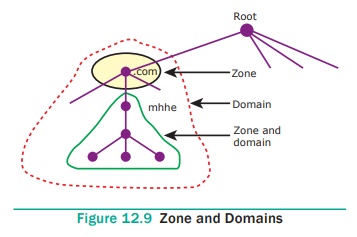

● A domain is a
single node of the Domain Namespace.
● A zone is a
subset of the Domain namespace generally stored in a file.
● Domain Name space
is an entire collection Domains, Sub domains and Zones
● Name server
manages the database of domain names and corresponding IP addresses.
● A server can
contain more than one zone files (Zones). A zone can contain more than one sub
domains
Resolver
Domain Name System is a client/ server application. A host system need to map domain name to IP address or vice versa according to the call and that work is done by resolver. Resolver either asks server to provide information about IP address. If it doesn’t find any information, then it sends the request to other servers and so on. Once the resolver receives the mapping, it checks whether it is an error or resolution (mapping) and provides result according to that.
The resolver is a
program which is responsible for initiating the translation of a domain name
into an IP address. Since a resolver isstored in the host, There is no need of
any protocol to form a connection between the resolver and the user program.
How DNS works?
When the user enters the URL (consists of protocol,
domain name, folder name, file name) in the browser, the system first checks
its DNS cache for the corresponding IP address. If the IP address is found in
the cache then the information is retrieved from cache. If not, then the system
needs to perform DNS query i.e., the system needs to query the resolver about
the IP address from Internet Service Provider (ISP). Each resolver has its own
cache and if it is found in that then that information is retrieved. If not,
then the query is passed to next domain server i.e., TLD (Top Level Domain)
which reviews the request and direct the query to name servers associated with
that specific domain. Until the query is solved it is passed to next level
domains. At last the mapping and the record are returned to the resolver who
checks whether the returned value is a record or an error. Then the resolver
returns the record back to the computer browser which is then viewed by the user.
Refer Figure 12.10
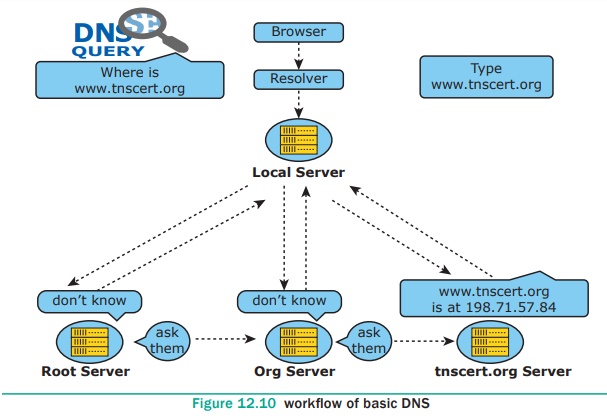
Web server is a
program running on dedicated machine which handle the queries of www enduser.
Server is used to host the websites and to deliver the contents of websites
using HTTP. While typing the URL in browser, the browser send the URL to DNS.
After getting an IP address from DNS, It sends the request to the web server
with IP address . Now the content of websites appear on browser.
IANA is an
affiliated authority of ICANN. IANA does the overall management of the DNS
Root, IP addressing, and other Internet protocol resource handling. IANA takes
care of a number of key aspects of the DNS, including the root zone, and the
domains .int and .arpa.

The WHOIS is a
service of ICANN. It is a free, publicly available directory containing the
details of registered domain names and their owners (registrants).
https://whois.icann.org/en
Related Topics